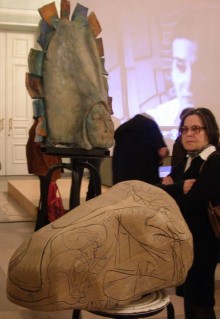Ada Rybachuk and Volodymyr Melnychenko had in common their lives, creative legacy, thoughts, work, and struggle, with eternity, too, joining this list now as Rybachuk departed this world so prematurely.
Melnychenko’s exhibition now on display at the National Academy of Arts of Ukraine is dedicated to her memory and the memory of their common friend Mykola Amosov, the great surgeon and philosopher whose 100th anniversary will coincide in time with the exhibition. Melnychenko devotes every day he lives without Rybachuk to ensuring that their common legacy will survive and, more importantly, go public. Symbolically, he is holding the exhibition in the room where once maestros of Ukrainian art accepted the two then-young artists’ diploma works, the fruits of their long work in the far North.
Rybachuk and Melnychenko’s creative interests were incredibly diverse in their use of art forms, ranging from monumental art to ceramics, architectural edifices and designs, tapestry, sculpture, graphic arts, plastic modeling… This list is endless. Some Kyivites are unaware that their works include Palace of Children and Youth in Slavy Square and Central Bus Station, as well as, for example, the first incarnation of the prize given at the famous KROK Festival of Animated Film. Unfortunately, fate or those mortals who arrogantly assume its mantle had it so that many of their works have mysteriously disappeared. One of their life’s works, the Wall of Remembrance at the Baikove Cemetery was savagely covered with concrete on orders of the day’s government, and hypocritic verbal explanations given by it were not much different from the present day. People may well disagree, but I see this temporary “devil’s bridge” as a source of hope, because in spite of all their evil plans and actions, the artists’ works live on and teach us how to live.
What gives meaning to Melnychenko’s life now is his effort to make his and Rybachuk’s legacy public. For years, they fought together to keep the studio intact, as that house in central Kyiv was too attractive for power holders. The artists had many supporters, but Larysa Skoryk was the one to put an end to this affair. Now, Melnychenko wants to preserve for the city this house, bright and full of unmatched aura of creativity and human interaction, as a house museum. The only lacking act is the authorities’ decision to declare the building an architectural monument under state protection.
There is no point in talking about the exhibition itself. Words cannot convey the diversity of images, thoughts, and passions on display there. It is better to see how the memory park and monument to Meisen could look, and what is hidden behind the Wall of Remembrance, buried under tons of concrete. By the way, according to Melnychenko, it may see the light of day yet, with enough funding and technical work. The exhibition is also a place to buy Melnychenko’s books, published by him over recent years and preserving for us part of Rybachuk’s vibrant soul.
In general, it is worth seeing and... thinking about. We all have a lot to think about.








